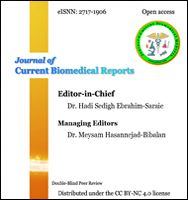Investigation of the effect of Lactobacillus paracasei TD3 on cutaneous wound healing and induction of angiogenesis on male Wistar rats
Abstract
Skin plays an essential role in the prevention of pathogenic microorganisms entrance. It is also considered as the first line of immune defense in our body. The therapeutic effects of probiotics on wound healing are well reported over the past decade. Nevertheless, there are limited publications about the impact of probiotics on skin wound healing. Here we assessed the effect of Lactobacillus paracasei TD3 on cutaneous wound healing in male Wistar rats. During this research, thirty-six male Wistar rats grouped into control positive, control negative, and trial groups, then the skins of rats were incised to make a full-thickness wound. An ointment produced from probiotic L. paracasei TD3 was administrated to the trial group, and immunohistological factors of each host were evaluated and compared with control groups. The final results showed that although L. paracasei TD3 could proceed the wound closure earlier than other groups and could induce angiogenesis in trial group, it could not cause any significant changes in the levels of monocytes, lymphocyte, mast cells and polymorphonuclear leukocytes in the trial group compared to control groups. This probiotic bacterium may be effective besides other probiotic bacteria.
Keywords
References
Cardoso CR, Favoreto S, Jr., Oliveira LL, Vancim JO, Barban GB, Ferraz DB, et al. Oleic acid modulation of the immune response in wound healing: a new approach for skin repair. Immunobiology. 2011; 216(3):409-15.
Bourke CD, Prendergast CT, Sanin DE, Oulton TE, Hall RJ, Mountford AP. Epidermal keratinocytes initiate wound healing and pro-inflammatory immune responses following percutaneous schistosome infection. Int J Parasitol. 2015; 45(4):215-24.
Janis JE, Kwon RK, Lalonde DH. A practical guide to wound healing. Plast Reconstr Surg. 2010; 125(6):230e-44e.
Velnar T, Bailey T, Smrkolj V. The wound healing process: an overview of the cellular and molecular mechanisms. J Int Med Res. 2009; 37(5):1528-42.
Guo S, Dipietro LA. Factors affecting wound healing. J Dent Res. 2010; 89(3):219-29.
Sinno H, Prakash S. Complements and the wound healing cascade: an updated review. Plast Surg Int. 2013; 2013:146764.
Weinstein-Oppenheimer CR, Aceituno AR, Brown DI, Acevedo C, Ceriani R, Fuentes MA, et al. The effect of an autologous cellular gel-matrix integrated implant system on wound healing. J Transl Med. 2010; 8:59.
Sasidharan S, Nilawatyi R, Xavier R, Latha LY, Amala R. Wound healing potential of Elaeis guineensis Jacq leaves in an infected albino rat model. Molecules. 2010; 15(5):3186-99.
Nagpal R, Kumar A, Kumar M, Behare PV, Jain S, Yadav H. Probiotics, their health benefits and applications for developing healthier foods: a review. FEMS Microbiol Lett. 2012; 334(1):1-15.
Lam EK, Yu L, Wong HP, Wu WK, Shin VY, Tai EK, et al. Probiotic Lactobacillus rhamnosus GG enhances gastric ulcer healing in rats. Eur J Pharmacol. 2007; 565(1-3):171-9.
Mimura T, Rizzello F, Helwig U, Poggioli G, Schreiber S, Talbot IC, et al. Once daily high dose probiotic therapy (VSL#3) for maintaining remission in recurrent or refractory pouchitis. Gut. 2004; 53(1):108-14.
Sazawal S, Hiremath G, Dhingra U, Malik P, Deb S, Black RE. Efficacy of probiotics in prevention of acute diarrhoea: a meta-analysis of masked, randomised, placebo-controlled trials. Lancet Infect Dis. 2006; 6(6):374-82.
Singer AJ, Clark RA. Cutaneous wound healing. N Engl J Med. 1999; 341(10):738-46.
Choi HJ, Ahn JH, Park SH, Do KH, Kim J, Moon Y. Enhanced wound healing by recombinant Escherichia coli Nissle 1917 via human epidermal growth factor receptor in human intestinal epithelial cells: therapeutic implication using recombinant probiotics. Infect Immun. 2012; 80(3):1079-87.
Pinchuk IV, Bressollier P, Verneuil B, Fenet B, Sorokulova IB, Mégraud F, et al. In vitro anti-Helicobacter pylori activity of the probiotic strain Bacillus subtilis 3 is due to secretion of antibiotics. Antimicrob Agents Chemother. 2001; 45(11):3156-61.
Rolfe RD. The role of probiotic cultures in the control of gastrointestinal health. J Nutr. 2000; 130(2S Suppl):396s-402s.
Brandi J, Cheri S, Manfredi M, Di Carlo C, Vita Vanella V, Federici F, et al. Exploring the wound healing, anti-inflammatory, anti-pathogenic and proteomic effects of lactic acid bacteria on keratinocytes. Sci Rep. 2020; 10(1):11572.
Zahedi F, Heydari Nasrabadi M, Tajabadi Ebrahimi M, Aboutalebi H. Comparison of the effects of Lactobacillus brevis and Lactobacillus plantarum on cutaneous wound healing in rats.J Food Process Technol. 2012; 3(10):157.
Khodaii Z, Afrasiabi S, Hashemi SA, Ardeshirylajimi A, Natanzi MM. Accelerated wound healing process in rat by probiotic Lactobacillus reuteri derived ointment. J Basic Clin Physiol Pharmacol. 2019; 30(3).
Gudadappanavar AM, Hombal PR, Timashetti SS, Javali SB. Influence of Lactobacillus acidophilus and Lactobacillus plantarum on wound healing in male Wistar rats - an experimental study. Int J Appl Basic Med Res. 2017; 7(4):233-8.
Lukic J, Chen V, Strahinic I, Begovic J, Lev-Tov H, Davis SC, et al. Probiotics or pro-healers: the role of beneficial bacteria in tissue repair. Wound Repair Regen. 2017; 25(6):912-22.
Fijan S, Frauwallner A, Langerholc T, Krebs B, Ter Haar Née Younes JA, Heschl A, et al. Efficacy of Using Probiotics with Antagonistic Activity against Pathogens of Wound Infections: An Integrative Review of Literature. Biomed Res Int. 2019; 2019:7585486.
DOI: https://doi.org/10.52547/10.52547/JCBioR.2.3.107
Refbacks
- There are currently no refbacks.
Copyright (c) 2021 © The Author(s)

This work is licensed under a Creative Commons Attribution-NonCommercial 4.0 International License.













